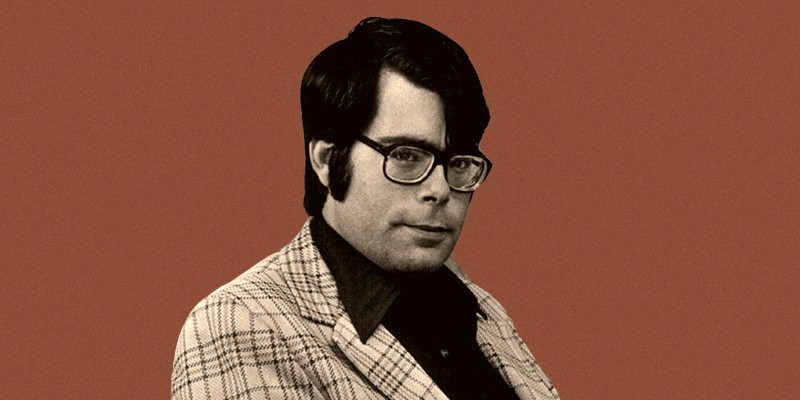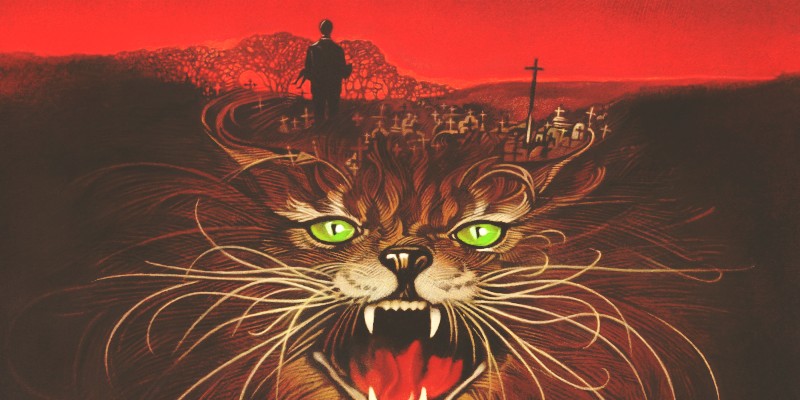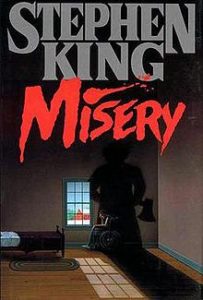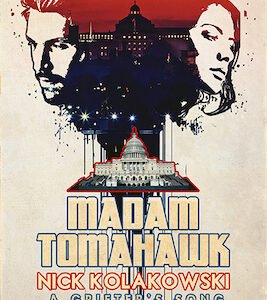Once I got over the excitement of being asked to write an essay for CrimeReads, I settled into several days of racking my brain over exactly what to write. Essays and articles, for me, are more difficult than writing a full novel. My 7th novel, and newest release, is called The Nightmare Man, a story where nightmares come to life, so I initially migrated toward writing something about dreams and nightmares and folklore and legends, which all cover many of the book’s main themes, but I kept coming back to this being my first horror/crime novel, the first under my pen name, and I got to thinking: I’ve had one interesting road getting to this point in my career, and I think it’s interesting enough to tell people about it, with the main idea being that every writer’s journey is unique, that we all leaned on others to get where we are, and that so many have taken that road less traveled.
And I, like many others, owe my career to Stephen King.
Other than the fact that I was a tennis pro for 26 years, and that I at one time hated to read, perhaps the most interesting fact about me is that I still type with 2 fingers. My two middle fingers, in fact, not so much as a big FU to whoever rejected my work over the decades, but simply because they’re my longest fingers and they hit the keyboard before the others. But imagine Johnny Depp as Edward Scissorhands cutting hair in the movie, and that’s what it looks like when I’m typing. Minus Johnny’s looks, of course. But now that that nugget is out there, I’ll start from the beginning, back to when I hated to read, before a certain teacher changed my life.
As with many kids, it wasn’t so much that I hated to read. It had more to do with hating what I was reading—which, to be honest, was mostly the so-called classics. The life-changer for me was during my junior year of high school, when my English teacher, the late Roger Eppinger, had us read The Catcher in the Rye by J.D. Salinger, but then, after we finished it, went on to say, “Okay, enough of the classics, we’re going to read Stephen King the rest of the year!” I was like, wait, what? At first, we thought he was joking. Up until that point, I’d seen Stanley Kubrick’s movie version of The Shining, and it rocked my world as my introduction to horror—along with watching The Exorcist at way too young of an age—but I had never read Stephen King’s novel. Although I was aware enough to know he’d written it.
The first book we read that year, after J.D. Salinger, was Stephen King’s Different Seasons, which is a book made of four novellas: Rita Hayworth and The Shawshank Redemption, Apt Pupil, The Body, and The Breathing Method. Needless to say, the stories in that book blew me away—none more so than the chilling realness of Apt Pupil, which still haunts me—because the stories were so different from anything I’d ever read. I remember thinking, so this is what books can be? This is what books can do? I realized then that it wasn’t reading I hated, but rather, I had yet to find that right book, that right author, and for me, right away, that became Stephen King. I went from literally hating to read to loving it in a matter of weeks, like a gateway had been opened for me, and I don’t think there has been a day since then where I haven’t at least read a few pages of something. Unlike with the “classics,” the entire class read these stories, and it showed with how engaged everyone was in the discussions of them. I read and reread. I stared at the covers and imagined owning every version of them. Imagined my name one day being on something like that, a real book!
After Different Seasons, we read the four novellas in the Richard Bachman books, Rage, The Long Walk, Roadwork, and The Running Man, and the written word then seeped into my bone marrow. I also thought at that point, if I were ever to become a writer, how cool it would be to have a pen name! One day, I thought, one day! I remember that winter, while waiting in a grocery store checkout lane and eyeing the mass market paperback copy of Four Past Midnight on the rack and asking my parents if I could get it, and they looked at me like I’d switched personalities, because until then for me it was sports twenty-four-seven. Intrigued, they threw out the couple of bucks it took to buy it, and I devoured those four novellas as well, The Langoliers, Secret Window, Secret Garden, The Library Policeman, and The Sun Dog, reading those outside of and in between those we were reading in the classroom. My cousin was in the same class as me and he read those same novellas, and we still reference them today. Years later, after reading The Stand, the term Captain Trips became part of our daily lexicon, and even now, decades removed from when we first read it, we still say someone has Captain Trips anytime we hear anyone cough or sneeze.
Creepshow, King’s graphic novella turned movie was the story that made me wonder for the first time what it was about horror and crime that had me so hooked. I was not a violent person—I’m non combative and have never been in a fight in my life—yet violence and the dark side of nature has always lured me. In fact, I loved to be scared. I also realized that until that point, I’d only read King’s novellas, which, in my opinion, are still some of his best works. But I thirsted for more! And so onward to The Shining, which introduced me to how vastly different books can be from movies, as far as depth of character, backstories and overall plotting. And then Pet Semetary, a haunting story that, to this day, still hammers home what horror truly is and can be, not so much with violence and gore, but in the moral dilemmas and horrifying situations in which the characters so often find themselves.
After joining the Stephen King Library in the late 1980’s, where each month, for years, I received a fancy new red leather-bound, gold-embossed book, I devoured one King after the next before eventually catching up to read them as they were published, right about the time Nightmares and Dreamscapes came out, and the cover of that book—specifically the creepy scarecrow—stayed with me long enough to inspire what eventually would become my first published horror novel, The Nightmare Man.
I knew one day, to fill my reading time, I would have to look for authors other than King, and Clive Barker’s The Great and Secret Show taught me how much minds can bend. And then I discovered Dean Koontz. I’ve read most of his books, but the ones that hit home for me, right around my college years, were Strangers, Lightning, Watchers, The Bad Place, Hideaway, Mr. Murder, and Dark Rivers of the Heart. Koontz really introduced me to the supernatural, but even more, the idea of a hero or heroine versus a true villain, and none more chilling than in his novel Mr. Murder. That novel, along with King’s The Dark half and Misery, were monumental for me, not only in my dream to be a writer but inspired me to finally take the plunge and start writing. They’re also the reason why I started my horror career off with the writer-as-a-main character theme in The Nightmare Man; not only that, but the book-within-a-book theme as well. Because of Misery, I insisted on writing my very first novel, in my early twenties, on a real typewriter. I self-published that book way back when and mostly pretend it doesn’t exist, but I honestly think without having done so, I may have given up early on. Because of Stephen King, I learned of Peter Straub, and soon powered through all his books, with The Talisman (written with King) and Ghost Story moving literary mountains for me. Straub’s character development and slow-burn plotting taught me so much about atmosphere and underlying tension. Around that same time, another teacher—thank you Tim Burke—loaned me a copy of Robert McCammon’s Boy’s Life and I loved it so much I didn’t want to give it back. His prose is second to none. Finding another very similar copy of it in a used bookstore a year ago sure brought back memories. Anne Rice’s writing in Interview with the Vampire was so real I could see, taste, and smell the words as I read them.
My second and third novels, both unpublished, were also horror novels, and I hope to one day rewrite and publish them under my pen name. But to make a long story short, I wrote three and a half novels through my twenties and early thirties and battled through ten years of rejections before finally signing with an agent who then sold my first novel to Sourcebooks, published in hardcover in 2013. But unlike my previous attempts, this novel was historical fiction. Funny how things turn out. But since that one was historical, future book deals dictated I write historical fiction for my next five novels. Even more unplanned was that my second novel sold to one of the Big 5’s Christian Fiction imprints. I didn’t even know what Christian Fiction was, and certainly hadn’t gone into it trying to write one, but because a miracle takes place in the story and a homeless man in the book acts like a Christ figure, that’s where it went. But hey, I was getting paid to write, and the plan was to use my books to help cross over to mainstream, so I kept writing them. I’m proud of those four novels, and even added elements of magical realism and horror into them, but because of the content and violence I got hammered by conservative Christians, more than once, receiving emails that perhaps I might be going to hell! Those books are far more mainstream than Christian—they’re more redemptive than anything—but they never crossed over and therefore didn’t sell as hoped, and because of it, for a couple of years, my career stalled.
And I still had that seed in my head to write something scary.

Stuck and waffling over which direction to go, and having secured my third and hopefully final agent, I decided to double-back to why I fell in love with reading and writing in the first place, back to themes that scared me and unnerved me and absolutely took me to another time and place, in reading such influential books like Caleb Carr’s The Alienist and The Angel of Darkness, and years later, the world-building masterpieces of atmospheric beauty, The Shadow of the Wind and The Angel’s Game by Carlos Ruiz Zafon. These four novels inspired me to write my sixth novel, a dark historical thriller about a man with two personalities—a nod to Jekyll and Hyde—and it was while writing this that I decided to make my own split as a writer. To try again to write contemporary horror, this time under a pen name, while continuing to write historical under my own. Early on in my writing career I was simply not good enough, but I hoped by now, that perhaps I was. But I wouldn’t know until I started putting words on paper.
To put me on the right path while writing The Nightmare Man, I returned to my roots, to where it all began for me, and started rereading Stephen King, from Carrie on through, and while I’m still far away from reading them all twice, it put my creative mind in the place it needed to be in order to start this necessary rebranding of my career, and rekindling my love of horror in general. I opened a used bookstore/bar that was amazing for the 10 months it lasted, before covid eventually killed it, but during that span I had a popular Stephen King book club that grew every monthly meeting. I did readings from Poe at Halloween, and we had a horror section I was quite proud of, highlighted by multiple shelves of King’s work.
Every writer has books that influenced them, and these, as far as horror, are mine. I have other writers I leaned on along the way, of course, such as Greg Iles, Ken Follett, John Irving, Colleen McCullough, Don Winslow, Tana French, Dennis Lehane, Elizabeth Strout, Pat Conroy, and more recently with such great Book Twitter friends like Chris Bohjalian and Stephen P. Kiernan, but these books I’ve listed are the ones that most influenced how I write, and why I write. I’m one of an army of writers, no doubt, turned onto the craft by Stephen King, but I truly believe this current era is golden because of him—all kids at one point who probably picked up a Stephen King book and fell in love with his creepy and sometimes elegant worlds—with writers like Stephen Graham Jones, Jennifer McMahon, Ania Ahlborn, Joe Hill, Tananarive Due, Jonathan Janz, Paul Tremblay, Grady Hendrix, T. Kingfisher, Josh Malerman, Alma Katsu, Chuck Wendig, Catriona Ward, and too many others to list, now leading the charge. My only hope is that I can keep up. If not, King will always be there, whether he ever knows it or not, to give me that needed boost.
***






















